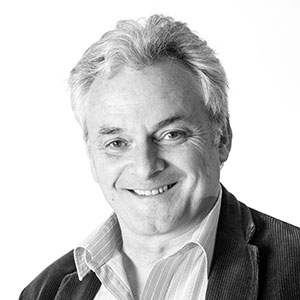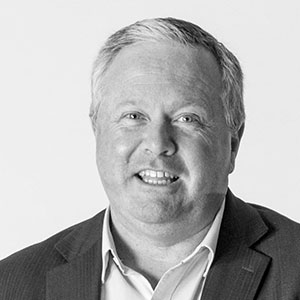The 2016 Government Defence White Paper puts research partnerships front and centre – “Key to the successful delivery and sustainment of our enhanced defence capabilities will be a new level of collaboration with Australian defence industry and science and technology research organisations.”
Engaging at that collaborative level is a hallmark UniSA strength, with researchers already making a valuable contribution to the defence industry.
 Director of UniSA’s Defence and Systems Institute, Professor Anthony Finn says unmanned vehicles are of increasing significance in the defence space.
Director of UniSA’s Defence and Systems Institute, Professor Anthony Finn says unmanned vehicles are of increasing significance in the defence space.
A future-of-the-Army panel at the annual meeting of the Association of the U.S. Army in Washington in October emphasised both the impact of artificial intelligence and automatic systems on the battle field and the need for future weapons and vehicles to have more kinds of intuitive, familiar controls.
Prof Finn’s research tackles not only the application of these technologies, but also how their use is best integrated with human forces.
“Under a previous project we built a test bed that allows us to measure the manner in which humans interact with multiple unmanned vehicles,” Prof Finn says. “The project tested the trust that humans place in these imperfect technologies.
“Our results can be used to figure out how defence could, for example, set up a cell of operators with unmanned vehicles to get the most out of how they are going to tackle complex situations based on how much the humans trust the systems.
“We have also been improving the value of autonomous systems and the technologies they employ. It’s not as simple as saying that we’ll replace human surveillance with drones - you need to understand what you want done and whether the system can actually deliver it.
“We are focused on making defence smarter and safer. We also want to extend the application of our work so we are looking at ways to apply niche technology to particular problems posed by the defence forces.
“Quite often we are using technologies we have developed for other reasons, and leveraging that work into defence. For example, we have work that helps the wine industry identify micro-climates within vineyards that could be applied to detecting, tracking and countering unmanned vehicles.”
With mathematics at the heart of some of the most sophisticated problem solving and systems development, Prof Finn’s team is also working on state-of-the-art tracking systems.
“Our work in this area has been useful for several platforms—submarines and the Airborne Early Warning and Control Aircraft, with focus on making algorithms more robust and computationally efficient,” Prof Finn says.
“One of our current projects is to improve a passive tracking system – one based on the sounds made by others and thus able to go undetected.
“The field is exciting because it’s a complex space and we are talking about advances that may give us a defence edge.”
Over in UniSA’s School of Engineering, mathematics is also a significant factor in the big defence projects that engineering researchers are involved with.
 Associate Professor Kutluyil Dogancay, who has been collaborating with the Joint and Operations Analysis Division in the Defence Science and Technology Group (DST Group) for more than 10 years, finds his work with defence inspiring.
Associate Professor Kutluyil Dogancay, who has been collaborating with the Joint and Operations Analysis Division in the Defence Science and Technology Group (DST Group) for more than 10 years, finds his work with defence inspiring.
“It’s really great to work on projects of national significance,” Prof Dogancay says.
“These are significant projects and there is a lot at stake in terms of outcomes. It’s great to be able to put our knowledge and expertise to use in highly practical and significant projects.”
Prof Dogancay works on advanced software development, using his team’s optimisation, applied mathematics and signal processing expertise to guide technical development in various areas of defence for Australia. Recently he has used simulation scenarios to test military helicopters that the Government was assessing for acquisition.
“Before an acquisition decision was made, we ran a series of simulations to test how the helicopter would be able to accomplish various tasks – quite specific things, such as how it might perform in defending a Navy ship against a threat from a small shipping boat,” Prof Dogancay says.
“It’s almost like gaming, but using virtual reality, and from our simulations we can extract data that helps us to build models and recommendations for best use. Our research can advise on things like the best flight strategy or optimal flight pattern in particular scenarios.”
Simulation work for the DST Group is also being under-taken at UniSA’s Advanced Computing Research Centre.
 A team of researchers, led by Advanced Computing Research Centre Director Professor Markus Stumptner, has developed enhanced behaviour modelling software that is the fastest in the world at modifying existing combat strategies. This will allow Australia’s military personnel to prepare and execute advanced combat simulations across multiple environments much more quickly and efficiently.
A team of researchers, led by Advanced Computing Research Centre Director Professor Markus Stumptner, has developed enhanced behaviour modelling software that is the fastest in the world at modifying existing combat strategies. This will allow Australia’s military personnel to prepare and execute advanced combat simulations across multiple environments much more quickly and efficiently.
This is an advantageous development with the wars of the future expected to be considerably accelerated with a barrage of new technology.
Prof Stumpner says the new software could result in being able to challenge and alter a traditional approach to how military personnel respond when they come under fire, based on applying the latest data from real world scenarios.
“By enhancing the speed by which simulations can be created, it allows military personnel to experience the most advanced combat scenarios using real world military tactics and procedures,” Prof Stumpner says.
“This sort of capability will make them a world leader in performing combat simulations, allowing them to stay ahead of the curve in evaluating new tactics and equipment being considered for deployment.”
And if the work being undertaken by a research team at the Future Industries Institute comes to fruition, then Australia’s defence personnel could soon be driving in vehicles with high-tech camouflage capabilities.
Heading up the research team is  Professor Peter Murphy, Strand Leader and David Klingberg Chair in Energy and Advanced Manufacturing.
Professor Peter Murphy, Strand Leader and David Klingberg Chair in Energy and Advanced Manufacturing.
His goal is to deliver technology that will allow Australia’s military vehicles to literally blend into the background with thin film coatings technologies that deliver chameleon capacity.
Prof Murphy’s team adapted their materials science, process development and nano-engineering expertise to create an original camouflage prototype out of glass. However, as Prof Murphy says, glass is obviously not a material suitable for warfare, so the team is now working with a polycarbonate plastic that is just 1.5mm thick.
“Ideally we need a material thin enough and light enough that it can be put over an army tank,” Prof Murphy says.
“We need the cells to be truly flexible but also as big as possible.”
The current prototype consists of two very thin sheets of plastic that have an electrical circuit between them. The gap between the two sheets of plastic is thinner than a strand of hair. It’s a complicated project that has to take into consideration the many factors that will affect the technology in the field.
“It has to be a product that is easily deployed and that can cope with all sorts of weather extremes,” Prof Murphy says.
“Plastic is flexible but it can deform when exposed to heat. It’s a lot lighter than glass, in fact half the weight, but our product needs to be robust enough to survive getting bumped and scratched.
“There are a lot of factors to consider and it’s not just a case of using one discipline to solve this problem.
“We have to be able to combine fundamental science and engineering to create something that’s relevant to the real world – and that’s true for all of our projects.
“As we train young scientists, we train them to work across disciplines because when we are faced with a problem for defence or any other industry, we always look at what outcome is required, what the end user needs delivered.
“We work backwards from there to figure out what science we need to use to make that happen.”
Also working on a defence project that involves the capacity to go undetected, is UniSA’s Institute for Telecommunications Research (ITR). The group regularly works on projects with the DST Group – one of those at the moment is looking at Free Space Optical (FSO) Communications which uses light emitted by lasers propagating in free space.
 Associate Professor Gottfried Lechner, Director of the ITR, explains that the advantages of FSO include very narrow beams that are hard to intercept.
Associate Professor Gottfried Lechner, Director of the ITR, explains that the advantages of FSO include very narrow beams that are hard to intercept.
“Some applications are high speed data links for video transmission and ship-to-ship communications with low probability of interception,” Assoc Prof Lechner says.
“Our ongoing partnership with the DST Group in developing FSO systems range from software-based implementations to dedicated hardware for high speed communications.”
In another major project, ITR is using its telecommunications expertise to develop cooperative communications systems.
“In current systems, for example, a radio on an army vehicle communicates to a base station and the signals from other vehicles interfere with the communication,” Assoc Prof Lechner says.
“Our research uses a cooperative approach, where multiple radios on multiple vehicles form a large distributed antenna that allows for an increased range of communication. These systems are more robust against interference and jamming.”
The improvement in the communications systems is thanks to the rapid development of software defined radios (SDRs). While past devices were restricted to a particular communications scheme or standards, Assoc Prof Lechner says SDRs can adapt to multiple schemes depending on the current requirements, as well as being powerful enough to allow the implementation of novel communications systems.
These software and system improvements, along with input from experts like UniSA’s researchers, will go a long way to meeting the Federal Government’s aim of creating a more “agile and potent force”.